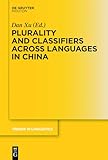Plurality and Classifiers across Languages in China / ed. by Dan Xu.
Material type: TextSeries: Trends in Linguistics. Studies and Monographs [TiLSM] ; 255Publisher: Berlin ; Boston : De Gruyter Mouton, [2012]Copyright date: ©2013Description: 1 online resource (288 p.)Content type:
TextSeries: Trends in Linguistics. Studies and Monographs [TiLSM] ; 255Publisher: Berlin ; Boston : De Gruyter Mouton, [2012]Copyright date: ©2013Description: 1 online resource (288 p.)Content type: - 9783110293821
- 9783110293982
- Chinese language -- Grammar
- Chinese language -- Quantifiers
- Grammar, Comparative and general -- Number
- Grammar, Comparative and general -- Quantifiers
- Sociolinguistics -- China
- Sociolinguistics -- China
- Chinesische Sprache
- Sprachkontakt
- LANGUAGE ARTS & DISCIPLINES / Linguistics / General
- Chinese Languages
- Grammaticalization
- Language Contact
- Linguistic Typology
- Non-Han Languages
- online - DeGruyter
- Issued also in print.
| Item type | Current library | Call number | URL | Status | Notes | Barcode | |
|---|---|---|---|---|---|---|---|
 eBook
eBook
|
Biblioteca "Angelicum" Pont. Univ. S.Tommaso d'Aquino Nuvola online | online - DeGruyter (Browse shelf(Opens below)) | Online access | Not for loan (Accesso limitato) | Accesso per gli utenti autorizzati / Access for authorized users | (dgr)9783110293982 |
Frontmatter -- Table of contents -- Preface -- Introduction Plurality and Classifiers across languages of China -- I Correlations between different types of quantification -- 1 Numeral classifiers with plural marking. A challenge to Greenberg -- 2 Reduplication in languages: A case study of languages of China -- II Numeral classifiers and their diachronic development -- 3 The Syntax and prosody of classifiers in Classical Chinese -- 4 Individuating classifiers in Early Southern Min (14th–19th centuries) -- III The expression of plurality -- 5 Plurality and the subclassification of Nouns in Classical Chinese -- 6 Number in Chinese: a diachronic study of zhū 諸 from Han to Wei Jin Nanbeichao Chinese -- 7 Bu-tong ‘different’ and nominal plurality in Mandarin Chinese -- 8 Plurality in the pronominal paradigms of Bai dialects -- 9 Frequentative aspect and pluractionality in Nuosu Yi -- 10 Quantificational structures in three-yearold Chinese-speaking children -- Author index -- Subject index
restricted access online access with authorization star
http://purl.org/coar/access_right/c_16ec
Plural marking, numeral classifiers and reduplication constitute the main means of quantification marking in the domain of grammar. The contributions in this book focus on the typological correlation between the three different strategies for quantification, as well as on some general issues. A better understanding of the quantification strategies in the languages of China will enrich our comprehension of human language and thought. The book is expected to have an impact on the study of linguistic typology, language contact, and patterns of the evolution.
Issued also in print.
Mode of access: Internet via World Wide Web.
In English.
Description based on online resource; title from PDF title page (publisher's Web site, viewed 28. Feb 2023)


